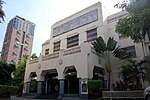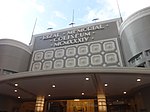Vito Cruz station (LRT)

Vito Cruz station is an elevated Light Rail Transit (LRT) station located on the LRT Line 1 (LRT-1) system in Malate, Manila. It is the first station from Baclaran and the last station from Fernando Poe Jr. to lie within Manila city bounds. The station takes its name from the former Vito Cruz Street (now Pablo Ocampo Sr. Street), which was named after a former alcalde mayor of Pineda (present-day Pasay) c. 1871. The station is the fifth station for trains headed to Fernando Poe Jr. and the sixteenth station for trains headed to Baclaran. The station is near some major landmarks, such as the Bangko Sentral ng Pilipinas complex, the University Mall shopping center, and the Rizal Memorial Sports Complex, where some of the sports in previous Southeast Asian Games were played. The Cultural Center of the Philippines Complex is near this station as well, although commute is also an option due to its distance. Located in this complex are the CCP Main Building, the Philippine International Convention Center, Folk Arts Theater, Manila Film Center, MBC Building, Star City, Aliw Theater and the Harbour Square. The station is also close to some educational institutions, such as the main campus of Arellano University School of Law, De La Salle University, De La Salle–College of Saint Benilde, and St. Scholastica's College. The southbound concourse of the station is connected to the adjacent University Mall, but is currently blocked off as the entrance has since been converted into tenant space. The station was also near Harrison Plaza, but it is currently demolished and undergoing redevelopment by SM Prime. Vito Cruz station is notorious for its unusually high number of suicide attempts. As a result, the LRTA has imposed a "speed limit" on trains entering stations to deter the number of successful suicides.
Excerpt from the Wikipedia article Vito Cruz station (LRT) (License: CC BY-SA 3.0, Authors, Images).Vito Cruz station (LRT)
Taft Avenue, Manila Malate (Fifth District)
Geographical coordinates (GPS) Address External links Nearby Places Show on map
Geographical coordinates (GPS)
| Latitude | Longitude |
|---|---|
| N 14.563475 ° | E 120.99468055556 ° |
Address
Vito Cruz
Taft Avenue
1004 Manila, Malate (Fifth District)
Philippines
Open on Google Maps







